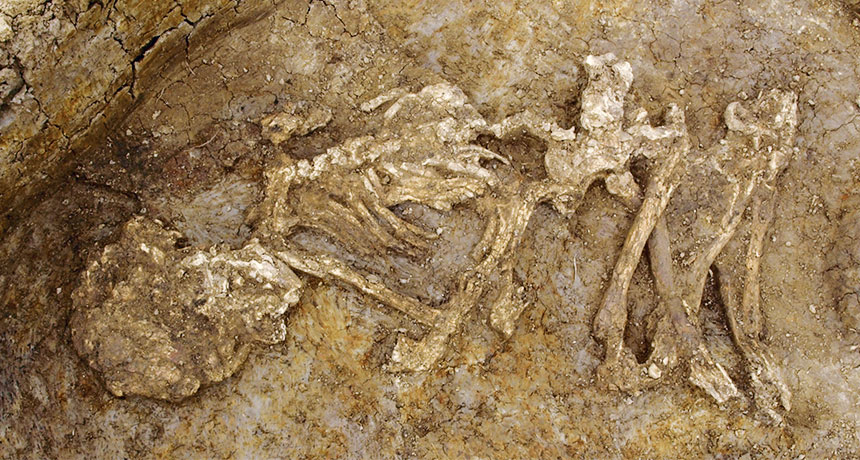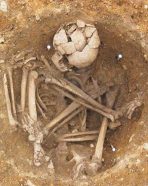Bronze Age mummies unearthed in Great Britain
Remains suggest some bodies would have been dried by smoking to prevent decay

This Bronze Age skeleton was unearthed in southeastern England. It shows so little bacterial decay that it must have been mummified shortly after death, a new study concludes. Some bone damage does suggest the body was preserved by smoking.
Geoff Morley
By Bruce Bower
Signs that ancient Britons mummified their dead were kept under wraps — until now.
The Bronze Age corpses had been buried at sites throughout Great Britain. Close inspection of their bones indicate the bodies had been intentionally mummified, a new study finds. The remains date to between about 4,200 and 2,750 years ago.
Thomas Booth of the Natural History Museum in London and his colleagues analyzed bones from 34 bodies. Sixteen showed little to no bacterial damage. That suggests mummification had blocked rapid decay of a corpse’s flesh, Booth’s team says. The researchers describe their findings in the October Antiquity.
The hot, dry climates of ancient Egypt and South America’s Andes preserved ancient mummies there. Such arid environments would have deprived gut microbes of the moisture they would have needed to survive long enough to break down tissue. But damp Britain would have offered corpses no such protection against such decay.

At a time when ruling classes increasingly controlled farmland, mummies could have helped affirm a descendant’s ancestry, Booth says. This, he adds, may have helped uphold claims to ancestral lands and rights.
The new findings also “raise the question of how widespread such mummification might have been beyond Britain,” says Martin Smith. He’s an anthropologist at Bournemouth University in Poole, England.
How they determined mummification had occurred
Mike Parker Pearson works at University College London. He also is a co-author of the new study. Ten years ago, he led a research team that found evidence of Bronze Age mummies at a site in Scotland. There, too, no signs of bacterial decay emerged.
As an initial test of whether bones alone can identify mummification, Booth’s group examined ancient bones from two known mummies. One body came from an Irish peat bog. The other had dried out rapidly in a desert. It came from Yemen, a site in the southern Arabian Peninsula.
The Yemeni bones showed little bacterial damage. Slightly more — though not much — appeared on the Irish bones. In their case, tissue decay appears to have started before their body had been immersed in the bog. Other researchers have also reported little or no bacterial decay on bones from 10 mummified people. These included Ötzi the Ice Age man who died some 5,300 years ago. (His body was found in 1991, frozen in the Italian Alps.)
Concludes Booth, researchers now can confirm ancient mummification from bones alone. As such, he says, “There is such a thing as a mummified skeleton.” And that’s how his team came to view 16 of the Bronze Age skeletons it studied.
Included among them were bones from two graves at a site Parker Pearson had studied in 2005. They were on Scotland’s Outer Hebrides islands. The new findings now confirm Parker Pearson’s initial claim of mummification there. The findings also extend Bronze Age mummification into central and southern England.
Mummification appears limited to the Bronze Age
Parker Pearson and his colleagues had found that each burial at the Scottish site contained body parts from three different people. Radiocarbon dating indicates that those six individuals had died several hundred years before being buried beneath a building. And that was some 3,000 years ago.
Britain’s Bronze Age kicked off around 4,000 years ago.
Bones from bodies that decayed rapidly show extensive bacterial damage when viewed under a microscope. So did nearly all bones — mainly upper-leg bones — from 35 individuals buried at British farming villages from before that Bronze Age, Booth’s team found. They found the same true for 183 people laid to rest some 2,000 years after the Bronze Age. So mummification in Great Britain seems to have been a practice restricted to Bronze Age communities.
No one knows for sure how the corpses were mummified. Some bones show signs of exposure to low-level heat. These bodies may have been dried out in smokehouses, Booth says. Bronze Age communities probably also mummified bodies in bogs and by removing internal organs of the dead, he adds.
Storing the dead above ground for long periods would have slowed their decay, says Christopher Knüsel. He’s an anthropologist of the University of Bordeaux in France. Several Bronze Age skeletons now identified as mummified were buried with their legs tucked under their chins. To him, this suggests they had been bundled and stored somewhere before burial. Indeed, delayed burial for community leaders may have enabled extended funeral ceremonies and rituals, he says.
Power Words
(for more about Power Words, click here)
anthropology The study of humankind. A social scientist who studies different societies and cultures is called an anthropologist.
archaeology The study of human history and prehistory through the excavation of sites and the analysis of artifacts and other physical remains.
arid A description of dry areas of the world, where the climate brings too little rainfall or other precipitation to support much plant growth.
bacterial Having to do with bacteria, single-celled organisms. These dwell nearly everywhere on Earth, from the bottom of the sea to inside animals.
bog A type of wetland that forms peat from the accumulation of dead plant material — often mosses.
Great Britain The territory of England and Wales. This is not the same thing as Britain, which refers only to England. It’s also not the same thing as the United Kingdom, which includes Northern Ireland in addition to all of Great Britain.
Briton A resident of Great Britain (meaning England or Wales).
bronze A metallic alloy that consists primarily of copper and tin, but may include other metals. It is harder and more durable than copper.
Bronze Age An archeological period that followed the Old and New Stone Ages. It was the first period in which ancient peoples started using metal. When this occurred varied around the world. In China and Greece, it happened at least 5,000 years ago. In Britain it occurred closer to 3,900 years ago. In the early stages, ancient peoples formed copper into useful tools. True bronze, a metal alloy formed from a mix of copper and tin, came later. Tin deposits in southern England led this region to become a major center of Bronze Age culture.
decay The process (also called rotting) by which a dead plant or animal gradually breaks down as it is consumed by bacteria and other microbes.
microbe Short for microorganism,a living thing that is too small to see with the unaided eye, including bacteria, some fungi and many other organisms such as amoebas. Most consist of a single cell.
mummify The process by which a corpse is preserved chemically or through drying. In many cases, communities have intentionally preserved certain members of their society. But bodies of some humans and animals have naturally mummified as the tissues dried out before microbes could degrade them (break them down, as by rotting).
peat Largely decomposed plant material that develops in the absence of oxygen within a water-saturated site, such as a bog. When dried out, peat can be burned as a low-grade fuel.
radiocarbon dating A process to determine the age of material from a once-living object. It is based on comparing the relative proportion, or share, of the carbon-12 to carbon-14. This ratio changes as radioactive carbon-14 decays and is not replaced.
tissue Any of the distinct types of material, comprised of cells, which make up animals, plants or fungi. Cells within a tissue work as a unit to perform a particular function in living organisms. Different organs of the human body, for instance, often are made from many different types of tissues. And brain tissue will be very different from bone or heart tissue.







